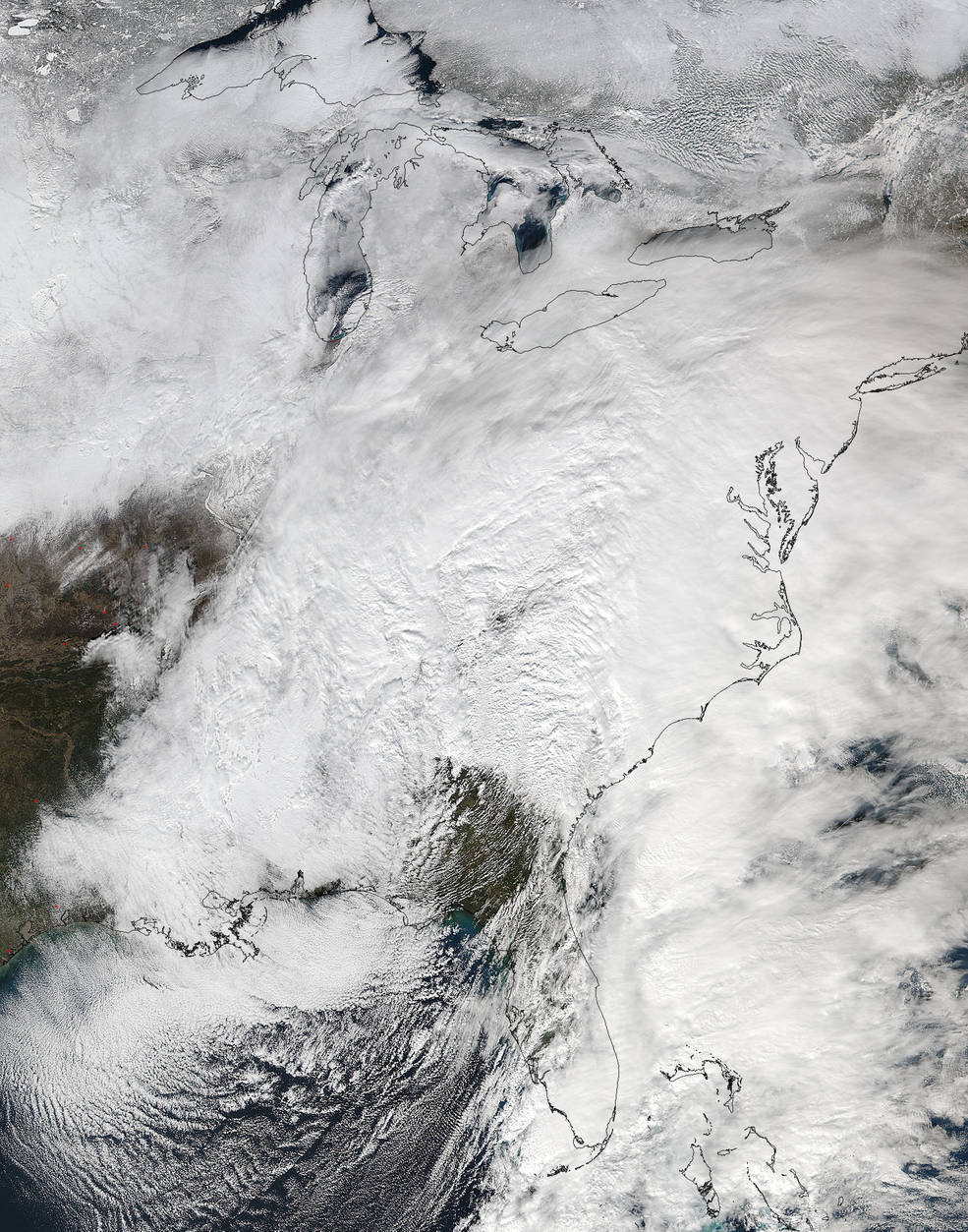Millions of Americans started digging themselves out Sunday after a mammoth blizzard with hurricane-force winds and record-setting snowfall brought much of the East Coast to an icy standstill.

New York and Baltimore began lifting travel restrictions and hearty souls ventured out on snow-choked streets, while mass transit systems up and down the coast gradually restored normal service.
Some airlines started to cut Monday service in addition to the 7,000 already-canceled weekend flights.
The massive snowstorm brought both the nation’s capital and its largest city to a stop, dumping as much as 3 feet of snow and stranding tens of thousands of travelers. At least 18 deaths were blamed on the weather, resulting from car crashes, shoveling snow and hypothermia.
The storm dropped 26.8 inches in Central Park, the second-most recorded since 1869 and just short of 26.9 inches set in February 2006. The 26.6 inches that fell on Saturday, however, was the city’s record for a single day.
The storm dropped snow from the Gulf Coast to New England, with areas of Washington surpassing 30 inches. The heaviest unofficial report was in a rural area of West Virginia, not far from Harpers Ferry, with 40 inches.
“This is kind of a Top 10 snowstorm,” said weather service winter storm expert Paul Kocin, who co-wrote a two-volume textbook on blizzards.
The usually bustling New York City looked more like a ghost town. With Broadway shows dark, thin crowds shuffled through a different kind of Great White Way, the nickname for a section of the theater district. And Bruce Springsteen canceled Sunday’s scheduled show at Madison Square Garden.
In Washington, monuments that would typically be busy with tourists stood vacant. All mass transit in the capital was to be shut down through Sunday.
In northern Virginia, streets began to show signs of life Sunday morning, though plow trucks outnumbered passenger vehicles. Chris Courtney, an investment adviser from Fairfax Station, called ahead to confirm he could complete his usual Sunday routine: a coffee and a newspaper.
“I wanted to give them business,” said Courtney, 61. “I’ve got to believe they worked all night, the plow drivers.”
Travel conditions were improving from the dangerously snowy, icy roads that led to crashes that killed several people Friday and Saturday. Those killed included a 4-year-old boy in North Carolina; a Kentucky transportation worker who was plowing highways; and a woman whose car plunged down a 300-foot embankment in Tennessee. Three people died while shoveling snow in Queens and Staten Island.
An Ohio teenager sledding behind an all-terrain vehicle was hit by a truck and killed, and two people died of hypothermia in southwest Virginia. In North Carolina, a man whose car had veered off an icy-covered road was arrested on charges of killing a motorist who stopped to help.
In Kentucky, Pennsylvania and West Virginia, drivers were marooned for hours in snow-choked highways.
Roofs collapsed on a historic theater in Virginia and a horse barn in Maryland, while seaside towns in New Jersey, Delaware and Maryland grappled with flooding.
The snow was whipped into a maelstrom by winds that reached 75 mph at Dewey Beach, Delaware, and Langley Air Force Base, Virginia, the weather service said. From Virginia to New York, sustained winds topped 30 mph and gusted to around 50 mph. And if that weren’t enough, the storm also had bursts of thunder and lightning.
Stranded travelers included Defense Secretary Ash Carter, whose high-tech aircraft, the Doomsday Plane, couldn’t land at Andrews Air Force Base in Maryland after returning from Europe. Carter was rerouted to Tampa, Florida.
Storm Causes Flooding
The massive winter snowstorm raised flood waters in communities up and down the Atlantic Coast Saturday, closing roads and prompting evacuations.
The first round of flooding came with the morning tide. As water began overflowing into streets in some towns again Saturday night, officials said the nighttime flooding wasn’t expected to be as severe.
A string of resort towns was temporarily isolated Saturday morning by floodwater that inundated homes and restaurants.
“A lot of properties have water in them. But it may not be until later Sunday that they can assess the damage,” said Diane Wieland, a spokeswoman for Cape May County.
Officials in other states, from North Carolina to New York, expressed similar concerns. By late Saturday morning, some people already had seen enough havoc.
“When the water just started rushing down, it was as impressive as some of the videos you saw of Japan during the tsunamis,” said Jason Pellegrini, owner of Steak Out restaurant in Sea Isle City, who was trapped inside by floodwaters. “It came in that fast.”
Another restaurant, The Lobster House, was partly submerged by the rising tide more than 20 miles away in Cape May.
“It touched everywhere,” said Keith Laudeman, the third-generation owner of the nearly century-old establishment on Cape May Harbor. “It even got to the equipment we moved and never thought would get touched.”
The water quickly receded and Laudeman said he has a crew of people preparing to clean the place so they can reopen in the coming days.
In Delaware, flooding closed a popular route to the state’s beaches and forced about a dozen people to leave the low-lying community of Oak Orchard. In Ocean City, Maryland, Delmarva Power cut electricity to hundreds of customers as storm surge flooding submerged equipment used to power the downtown area.
Gale warnings are in effect through Sunday morning along the North Carolina coast, the National Weather Service said, with winds of 30 mph expected along with rough seas.
Officials in New Jersey were assessing damage caused by the flooding. Firefighters went into a flooded area of Sea Isle City to battle a blaze at another restaurant that may have been linked to the high waters.
(Associated Press writers William Mathis, Scott Mayerowitz and Jake Pearson in New York; Alex Brandon and Lolita C. Baldor in Washington; Jessica Gresko in Arlington, Virginia; Ben Nuckols in Burke, Virginia; Juliet Linderman in Baltimore; Adrian Sainz in Memphis, Tennessee; Claire Garofalo in Louisville, Kentucky; John Raby in Charleston, West Virginia, Randall Chase in Dover, Delaware, Ed Donahue in Washington; and Bob Lentz in Philadelphia contributed to this report.)
Was this article valuable?
Here are more articles you may enjoy.

 Sanofi to Pay $100 Million to Settle Zantac Cancer Lawsuits
Sanofi to Pay $100 Million to Settle Zantac Cancer Lawsuits  Harvard Study Again Stirs the Pot on Demotech Ratings of Florida Carriers
Harvard Study Again Stirs the Pot on Demotech Ratings of Florida Carriers  UnitedHealth Data Leak May Affect ‘Substantial’ Swath of U.S.
UnitedHealth Data Leak May Affect ‘Substantial’ Swath of U.S.  Supplemental Claims Don’t Need to Include Damage Estimates, Fed Appeals Court Says
Supplemental Claims Don’t Need to Include Damage Estimates, Fed Appeals Court Says 